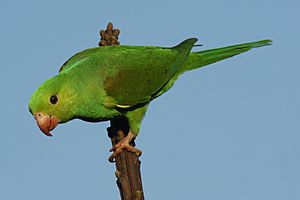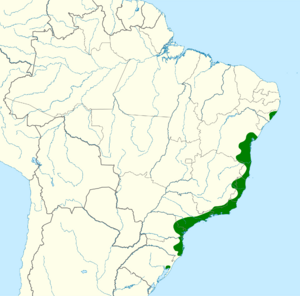Plain parakeet facts for kids
Quick facts for kids Plain parakeet |
|
|---|---|
 |
|
| In Brazil | |
| Conservation status | |
| Scientific classification | |
| Genus: |
Brotogeris
|
| Species: |
tirica
|
 |
|
The plain parakeet (Brotogeris tirica) is a type of bird that belongs to the parrot family. It lives only in Brazil. These small, green parrots are known for their friendly nature and are often seen in groups.
Contents
About the Plain Parakeet
Naming and Classification
The plain parakeet was first officially described in 1788 by a German scientist named Johann Friedrich Gmelin. He gave it the scientific name Psittacus tirica. Later, in 1825, another scientist named Nicholas Aylward Vigors placed it in a new group, or genus, called Brotogeris. This genus includes seven other types of parakeets.
The name Brotogeris comes from an old Greek word meaning "with human voice." This is because these parakeets can sometimes sound like they are talking! The second part of its name, tirica, comes from the Tupi language (an Indigenous language from Brazil) and means "tinkling." This word was used to describe a parakeet. There are no different types or subspecies of the plain parakeet; it's just one unique kind.
What Does It Look Like?
The plain parakeet is about 23 to 25 centimeters (9 to 10 inches) long. It weighs around 63 grams (2.2 ounces), which is about the same as a small apple.
Most of its body is green. Its neck area might have a slight bluish color, and its belly can look a bit yellowish. The top of its wings near the shoulder are a bronze or brownish-green color. Its flight feathers and the underside of its tail are bluish-green. The parakeet's beak is pinkish with a lighter color at the bottom.
Young parakeets look a lot like the adults, but their wings have less blue, and their tails are shorter. In some areas, especially in São Paulo state, you might see plain parakeets with a blue color change, which is quite unique!
Where Do They Live?
Plain parakeets live in eastern Brazil. You can find them from the state of Alagoas in the north all the way down to Santa Catarina in the south. There's also a separate group living in Rio Grande do Sul.
They prefer to live in the Atlantic Forest areas. This means you can spot them in forests that are growing back after being cut down, in farmlands with groups of trees, in plantations, and even in city parks. They are very common in big cities like Rio de Janeiro and São Paulo. In higher, inland areas, they also live at the edges and in the tops of mountain rainforests. While they mostly live in lower areas, they can be found as high as 1,200 meters (about 3,900 feet) above sea level.
Plain Parakeet Behavior
Movement and Travel
Plain parakeets do move around locally during different seasons. However, scientists are still learning exactly how and why they make these movements.
What Do They Eat?
These parakeets are not picky eaters! They mostly eat seeds, fruits, flowers, and nectar from many different kinds of plants and trees. They also sometimes eat adult insects and insect larvae (baby insects).
Reproduction and Life Cycle
The plain parakeet's breeding season is thought to be from September to December. It might even start earlier and end later. They make their nests in holes or cavities found in trees.
In places where they are cared for by humans, a female parakeet usually lays four eggs. The eggs hatch after about 26 days. The young parakeets are ready to fly out of the nest when they are about seven weeks old.
How Do They Communicate?
Plain parakeets have several different calls. They make a high-pitched, sharp "cree" sound or a two-part "cra-creep." They also have a lower, rougher "cra-cra-cra" call. They make these sounds both when they are sitting on a branch and when they are flying. When a group of parakeets is together, they often call out at the same time, making quite a noisy chorus!
Plain Parakeet Status
The IUCN (International Union for Conservation of Nature) has listed the plain parakeet as a species of "Least Concern." This means that they are not currently in danger of disappearing. Even though their living area is somewhat limited and we don't know their exact population size, their numbers are believed to be stable.
No immediate threats have been found for these birds. They are quite good at adapting to changes in their environment, much more so than other parrots that live only in southeastern Brazil. You can find them in many protected areas, which helps keep them safe.
Gallery





